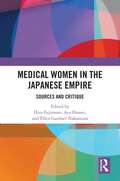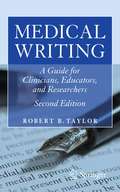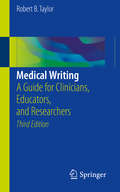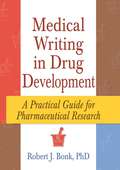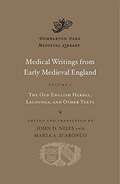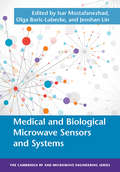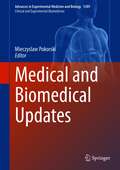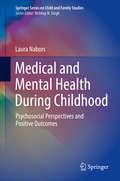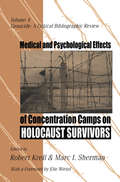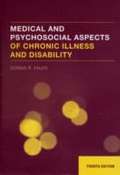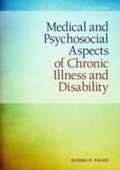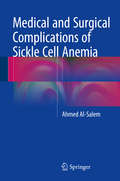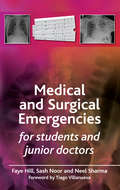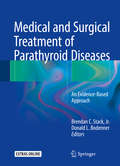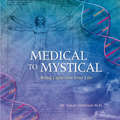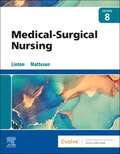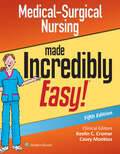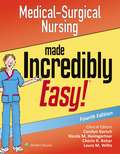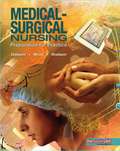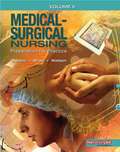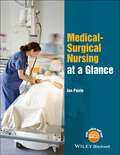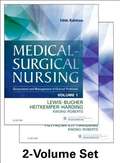- Table View
- List View
Medical Women in the Japanese Empire: Sources and Critique
by Aya Homei Hiro Fujimoto Ellen Gardner NakamuraFujimoto, Homei, and Nakamura bring together the perspectives of women engaging in professional medical work across the expanse of the modern Japanese Empire (1868–1945). Through translations of primary source documents in three East Asian languages, this collection provides a window into the experiences of women working in a variety of medical professions, including doctors, nurses, midwives, and nutritionists. The voices of these women, collected from books, magazines, diaries, roundtable discussions, and oral histories, speak of the challenges, hopes, triumphs, and at times despair that women faced in their medical studies and workplaces.While the women represent a kaleidoscope of political views both critical and supportive of the Japanese empire, this book demonstrates the significance of the Japanese nation and empire for many of these women. Their stories show how they pushed boundaries, traversed national or regional borders in search of medical opportunities, or attempted to carve out new spaces for women through their service as medical professionals.This work, which includes little studied sources never before accessible in English, will appeal to scholars and students of history, Asian studies, gender history/studies, and the history of science, technology, and medicine.
Medical Writing
by Robert B. TaylorThe first edition of this book (titled "The Clinician's Guide to Medical Writing") has become a standard in its field and remains an indispensible reference for any clinician, academic physician, or health professional who wishes to hone their writing skills. However, since its publication in 2004, significant changes have taken place in the way medical professionals communicate with each other and the world. Medical Writing: A Guide for Clinicians and Academicians, 2e retains all of the fundamental writing advice of the first edition and has been expanded to include two brand new chapters: How to Write a Research Protocol (including why a research project needs a written protocol, elements of the research protocol and common problems) How to Write a Grant Proposal (including sections on government and private grant funding sources, what you need to know about grant writing, and elements of a successful grant proposal) New information is also included throughout the book on becoming a successful writer, medical tables and figures, conflict of interest and disclosures, how to review a scientific article, statistical analysis, "pay-to-publish" journal publishing, electronic submission of manuscripts, issues in medical publishing and the future of medical writing and publication. New appendices address commonly encountered research and statistical terms and memorable aphorisms regarding writing, medical and otherwise.
Medical Writing
by Robert B. TaylorThis book is for the clinician who wants to write. It is for the physician, physician assistant, or nurse practitioner who sees patients and who wants to contribute to the medical l- erature. You may be an assistant professor aspiring to p- motion or a clinician in private practice who seeks the personal enrichment that writing can bring. If you are new to medical writing or even if you have been the author of some articles or book chapters and seek to improve your abilities, this book can help you. Who am I that I can make this assertion and write this book, both fairly presumptuous? Here's my reasoning. As a practicing physician, writing has been my avocation; unlike the authors of many other writing books, I am not a journal editor. Over 14 years in private practice and 26 years in a- demic medicine, I have written all the major models described in this book: review articles, case reports, edito- als, letters to the editor, book reviews, book chapters, edited books, authored books, and reports of clinical research st- ies. Most have been published. Not all. Perhaps my most signi'cant quali'cation is not that I have managed to p- duce a lengthy curriculum vitae. In my opinion, what is more important for you, the reader, is that I have made all the errors. That's right, the mistakes.
Medical Writing in Drug Development: A Practical Guide for Pharmaceutical Research
by Robert J BonkA guide through the maze of the pharmaceutical research and development process, Medical Writing in Drug Development fills a gap in the libraries of technical writers, college instructors, and corporate professionals associated with the pharmaceutical process. As it discusses critical information, such as strategies and techniques pivotal to crafting documents for drug development, it also overviews drug research, document types, the roles of professional writers, and information technology. In no time at all, you will be creating persuasive technical documents, building complex facts into coherent messages, and contributing to the effective marketing of new products with promotional pieces that meet legal and ethical standards.Medical Writing in Drug Development helps medical writers and scientific, regulatory, and marketing professionals develop a working knowledge of the technical documents crucial to successful drug research. New and seasoned professional writers alike will benefit from the book's detailed discussions of:using abstracts, slides, and posters to present up-to-the-minute researchhow patient-education materials, health-economic assessments, and electronic journals provide ongoing challenges in medical writinga dossier approach that expedites regulatory submissions for international drug developmentstructural constraints and rhetorical approaches toward regulatory documentspresenting intricate information in scientifically unbiased, yet technically convincing languagethe effects of electronic publishing, computer graphics, and related technology on the practice of medical writing within pharmaceutical researchPractical as a foundation text for undergraduate, graduate, and certificate programs in pharmaceutical or medical technical writing, Medical Writing in Drug Development will help you develop practical strategies for handling journal manuscripts, conference materials, and promotional pieces. No other text will clarify the main aspects of the pharmaceutical research and development process while offering you insight on the key issues dominating the healthcare arena.
Medical Writings from Early Medieval England Volume I
by John D. Niles Maria A. D'AroncoMedical Writings from Early Medieval England : The Old English Herbal, Lacnunga, and Other Texts -Language: old_english
Medical and Biological Microwave Sensors and Systems (The Cambridge RF and Microwave Engineering Series)
by Jenshan Lin Olga Isar Mostafanezhad Boric-LubeckeIn this comprehensive work, experts in the field detail recent advances in medical and biological microwave sensors and systems, with chapters on topics such as implantable sensors, wearable microwave tags, and UWB technology.<P><P> Each chapter explores the theory behind the technology, as well as its design and implementation. This is supported by practical examples and details of experimental results, along with discussion of system design, design trade-offs, and possible constraints and manufacturing issues. Applications described include intracranial pressure monitoring, vital signs monitoring, and non-invasive molecular and cellular investigations. Presenting new research and advances in the field, and focusing on the state of the art in medical and biological microwave sensors, this work is an invaluable resource for enthusiastic researchers and practicing engineers in the fields of electrical engineering, biomedical engineering, and medical physics.<P> Expert authors describe recent advances in state-of-the-art medical and biological microwave sensors and systems.<P> Includes practical examples and applications in biology and medicine.<P> Covers system design and design trade-offs.
Medical and Biomedical Updates (Advances in Experimental Medicine and Biology #1289)
by Mieczyslaw PokorskiThis book integrates topics in basic research and clinical medicine as well as molecular and cell biology.It presents innovative advances in the field of immunodeficiency syndromes and viral/bacterial respiratory infections, including a novel hyperbaric oxygen treatment for COVID-19. A comprehensive insight is offered into the unresolved molecular pathways in chemosensing that plays a vital role in detecting insufficient tissue oxygenation, as well as in sporting accomplishments. Other articles address cardiorespiratory and humoral responses to hypoxia, the function of cementum in the repair and regeneration of teeth, and periprosthetic fractures following hip arthroplasty in the elderly. The issue of the overwhelming burdens on caregivers to spinal injury patients, damaging both health and psychosocial status, is addressed.The book promotes translation of scientific advances to the general medical practice. It will be a valuable reference for clinical healthcare professionals and researchers interested in innovative practices to improve the prevention, diagnosis, and management of diseases.
Medical and Mental Health During Childhood
by Laura NaborsThis textbook provides a comprehensive overview of medical and mental illness in children, detailing how psychological, academic, and social functioning can be enhanced - and inherent challenges overcome - in young patients. The volume describes best-practices in depth, including how to ensure accurate diagnosis, developmentally appropriate treatment, and effective coordination between medical and school personnel. It discusses common medical conditions (e. g. , asthma, cancer, diabetes) and mental health conditions (e. g. , autism, ADHD, depression), emphasizing the critical role of health education in promoting optimal outcomes. Topics featured in this text include: Screening and diagnosis practices for children with medical and mental illness. Chronic and condition-related pain in children. Medical fears that may interfere with treatment and positive health behaviors Health education and coping strategies for children. Recommendations for family-directed interventions. Illustrative case studies and review questions. Medical and Mental Health During Childhood is an essential text for graduate students as well as a valuable reference for researchers, professors, and clinicians in clinical child and school psychology, social work, public health, family studies, educational psychology and counseling, health education, and allied disciplines.
Medical and Psychological Effects of Concentration Camps on Holocaust Survivors: A Research Bibliography (Genocide Ser. #Vol. 4)
by Robert Krell & Marc I. ShermanThis unique research bibliography is offered in honor of Leo Eitinger of Oslo, Norway. Dr. Eitinger fled to Norway in 1939, at the start of the World War II. He was caught and deported to Auschwitz, where, among others, he operated on Elie Wiesel who has written the foreword to this volume. After the war, Eitinger became a pioneering researcher on a subject from which many shied away. His contributions to understanding of the experience of massive psychological trauma have inspired others to do similar work. His many books and papers are listed in this special volume of the acclaimed bibliographic series edited by Israel W. Charny of The Institute on the Holocaust and Genocide in Jerusalem.In order to acquaint users of this bibliography with the topic, two introductory articles are offered. The first is titled "Survivors and Their Families" and deals with the impact of the Holocaust on individuals. The second, "Psychiatry and the Holocaust," examines the general impact of the Holocaust on the field of psychiatry. Robert Krell writes that in general the psychiatric literature has reflected critically on the survivor due to preconceived notions held by many mental health professionals. For many years, the exploration of victims' psychopathology obscured the remarkable adaptation made by some survivors. The problems experienced by survivors and possible approaches to treatment were entirely absent from mainstream psychiatric textbooks such as the Comprehensive Textbook of Psychiatry throughout the 1960s and 1970s.Fifty years of observations about survivors of the concentration camps and other survivors of the Holocaust (in hiding, as partisans, in slave labor camps) has provided a new body of medical and psychiatric literature. This comprehensive bibliography contains a plethora of references to significant pieces of literature regarding the Holocaust and its effects on survivors. It will be of inestimable value to physicians, psychiatrists, psychologists, and social workers, along with historians, sociologists, and Holocaust studies specialists.
Medical and Psychosocial Aspects of Chronic Illness and Disability (4th Edition)
by Donna R. FalvoMedical and Psychosocial Aspects of Chronic Illness and Diseases, Fourth Edition covers the medical aspects of those conditions commonly encountered by rehabilitation and other health professionals and discusses symptoms, diagnoses, treatments, and prognoses. This Fourth Edition has been completely revised and updated and reflects an approach consistent with the philosophical underpinnings of the International Classification of Functioning, Disability and Health (ICF). New chapters on Conceptualizing Chronic Illness and Disability; Intellectual Disability; and Financing Rehabilitation have been added. In addition, chapters on Psychiatric Disability, Substance Use, and Conditions of the Blood and Immune System have been expanded
Medical and Psychosocial Aspects of Chronic Illness and Disability (Fifth Edition)
by Donna R. FalvoThis book is designed as a reference for non-medical professionals and as a text for students who have little prior medical knowledge but who work with individuals with chronic illness and disability.
Medical and Surgical Complications of Sickle Cell Anemia
by Ahmed Al-SalemThis book is a wide-ranging guide to the diagnosis and management of the numerous medical and surgical complications that may arise in patients with sickle cell anemia. After introductory chapters on the genetics, pathophysiology, clinical features, and variants of sickle cell anemia, the complications observed in different parts of the body are addressed in a series of well-illustrated chapters. The coverage includes splenic, hepatobiliary, musculoskeletal, gastrointestinal, ophthalmological, cardio- and cerebrovascular, and renal complications, as well as acute chest syndrome, leg ulcers, hand and foot syndrome, acute appendicitis, and priapism. Treatment-oriented chapters consider perioperative management, blood transfusion therapy, hydroxyurea treatment, hematopoietic stem cell transplantation, and emerging strategies. The book is clearly written in a distinctive bullet point format for ease of reference and emphasizes especially aspects of practical significance. It will be of value for hematologists, general surgeons, internists, pediatricians, pediatric surgeons, fellows, residents, medical students, and nurses.
Medical and Surgical Emergencies for Students and Junior Doctors
by Neel Sharma Faye Hill Sash NoorLack of exposure and patient management during undergraduate and early postgraduate training often means both students and junior doctors can have difficulty managing acute medical and surgical situations. This pocketbook provides comprehensive coverage of the common medical and surgical emergencies encountered by medical students and junior doctors. It outlines possible symptoms, signs, differentials, investigations and management in a succinct, easy to comprehend format. By focusing on evidence-based practice, the guide provides the most up-to-date and clinically relevant guide for today's practice, ideal for quick reference on the wards.
Medical and Surgical Treatment of Parathyroid Diseases
by Jr. Brendan C. Stack Donald L. BodennerMedical and Surgical Treatment of Parathyroid Diseases is an accessible and user-friendly guide, addressing the key points of parathyroid diseases using case studies, as well as hundreds of high quality images and illustrations. Written and edited by respected leaders in the field of parathyroid surgery, this book aids in the comprehension of innovative concepts and focuses on the latest in clinical research. Written for otolaryngologists and oncologists at various stages of experience, Medical and Surgical Treatment of Parathyroid Diseases includes chapters dedicated to parathyroid anatomy, physiology, and embryology, medical therapy for parathyroid disease (indications and pharmacotherapy), diagnostic imaging, surgical treatments, and special topics such as health services and healthcare economics related to parathyroid surgery.
Medical to Mystical
by Susan JamiesonBiology, physiology, and physics combine with ancient traditions to explore the science of enlightenment-the interconnectedness of humanity and nature through the oneness of light-in this practical, spiritual guidebook. Written by a medical doctor who has embraced the spiritual side of healing, this analysis escorts readers on a journey through the light of DNA and physiological processes and connects this light to the Earth and the sun. Simple exercises show how to absorb, share, and hold the light, illustrating that manifesting its oneness will connect humans with each other as well as with nature. Touching on several aspects of healing-including chakras, Chinese meridians, earth and body energies, and Qi Gong-this part-medical, part-metaphysical guide illustrates that the science of enlightenment leads to personal and global well-being.
Medical, Psychosocial And Vocational Aspects Of Disability
by Martin Brodwin John Howard Frances Siu Erin Brodwin Ashley DuMedical, Psychosocial and Vocational Aspects of Disability (4th Ed. )
Medical-Surgical Nursing
by Adrianne Dill Linton Mary Ann MattesonProvide quality nursing care for adults with medical-surgical and psychiatric disorders!Building upon the fundamentals of nursing, Medical-Surgical Nursing, 8th Edition helps you master the role and responsibilities of the LPN/LVN in medical-surgical care. The text addresses the special problems of older adult patients, then covers each major disorder by body system, presenting patient problems, goals, outcome criteria, and nursing interventions. As LPN/LVNs do not formulate NANDA diagnoses, the book is organized by patient problems rather than NANDA nursing diagnoses. Written by noted educators Adrianne Dill Linton and Mary Ann Matteson, this text helps you build the clinical judgment skills you need to succeed on the Next-Generation NCLEX-PN® examination and in nursing practice.
Medical-Surgical Nursing Made Incredibly Easy (Incredibly Easy! Series®)
by Lippincott Williams WilkinsFeeling anxious or unsure about medical-surgical nursing care? Get grounded in the latest best practices, with the freshly updated Medical-Surgical Nursing Made Incredibly Easy!®, Fifth Edition. This colorful, fully illustrated guide offers clear, concise descriptions of crucial medical-surgical nursing concepts and procedures, with learning aids that help you grasp skills and concepts easily, in enjoyable Incredibly Easy style. From assessment and diagnostics to current evidence-based treatments and interventions, this is the perfect backup to class materials, a helpful support for new nurses, and a handy refresher for experienced nurses.
Medical-Surgical Nursing Made Incredibly Easy! (Incredibly Easy! Series® Series)
by Springhouse Publishing Company Staff Lippincott Williams and Wilkins StaffGet the vital concepts, data, and how-to on medical-surgical nursing with the newly updated Medical-Surgical Nursing Made Incredibly Easy, 4th Edition . This fun-but-informative guide uses colorful drawings and diagrams to demonstrate the mechanisms and clinical indications of the most common disorders found in each body system—followed by clear-cut direction on assessments, interventions, and evidence-based treatments. An ideal support to class materials and NCLEX ® preparation, this is also the perfect on-the-spot refresher for nurses in every kind of medical-surgical practice.
Medical-Surgical Nursing Preparation for Practice, Volume One
by Kathleen S. Osborn Cheryl E. Wraa Annita B. WatsonThis medical-surgical nursing textbook focuses on providing students with rationales for why they do what they do, and presents a foundation on which to build the nursing practice of today and tomorrow, including the cognitive, affective, and psychomotor skills necessary to practice.
Medical-Surgical Nursing Preparation for Practice, Volume Two
by Kathleen S. Osborn Cheryl E. Wraa Annita B. WatsonThe book consists of 16 units sequenced from simple, basic concepts to complex, medical-surgical disorders. The contents cover: introduction to general concepts related to health care delivery, followed by basic concepts related to nursing practice; physiological concepts and the theoretical basis of skills that are germane to all areas of nursing practice; focus on physiological disorders common to medical-surgical nursing.
Medical-Surgical Nursing at a Glance
by Ian PeateMedical-Surgical Nursing at a Glance is the perfect companion for study and revision for nursing and healthcare students from the publishers of the market-leading at a Glance series. This easy-to-read, accessible guide brings together all the key principles of caring for patients with medical and surgical needs. Highly visual, each topic is covered in one two-page spread, making it easy to quickly read up on key information and grasp the essentials of the key aspects of caring for the adult patient. A clear and accessible foundation of the need to know aspects of medicine and surgery for nurses Takes a systems approach exploring nursing care of key medical and surgical conditions and disorders Covers assessment, nutrition, pain, infection control Supported by a companion website with over 300 interactive multiple choice questions Provides need-to-know information in a quick-reference format Written from a UK perspective, with application to clinical practice Medical-Surgical Nursing at a Glance is ideal for nursing students looking for a clear and visual summary of care of the adult patient.
Medical-Surgical Nursing at a Glance (At a Glance (Nursing and Healthcare))
by Ian PeateMedical-Surgical Nursing at a Glance is the perfect companion for study and revision for nursing and healthcare students from the publishers of the market-leading at a Glance series. This easy-to-read, accessible guide brings together all the key principles of caring for patients with medical and surgical needs. Highly visual, each topic is covered in one two-page spread, making it easy to quickly read up on key information and grasp the essentials of the key aspects of caring for the adult patient. A clear and accessible foundation of the need to know aspects of medicine and surgery for nurses Takes a systems approach exploring nursing care of key medical and surgical conditions and disorders Covers assessment, nutrition, pain, infection control Supported by a companion website with over 300 interactive multiple choice questions Provides need-to-know information in a quick-reference format Written from a UK perspective, with application to clinical practice A companion website is available at www.ataglanceseries.com/nursing/medsurg featuring interactive multiple choice questions Medical-Surgical Nursing at a Glance is ideal for nursing students looking for a clear and visual summary of care of the adult patient.
Medical-Surgical Nursing, Volume 1: Assessment and Management of Clinical Problems
by Linda Bucher Sharon Lewis Margaret Heitkemper Mariann HardingThis book contains solid, research-based content presented in a concise, readable, and consistent format. Special features highlight the content that is most relevant and challenging for today's nursing students, including patient teaching, community and home care, gerontology, cultural and ethnic considerations, collaborative care, nutrition, and critical thinking. Nursing management content is discussed in a unique levels-of-care approach, with separate headings for Health Promotion, Acute Intervention, and Ambulatory and Home Care. More than just a textbook, it is a comprehensive resource with the essential information that students need to prepare for lectures, classroom activities, examinations, clinical assignments, and comprehensive care of patients.
Medical-Surgical Nursing, Volume 2: Assessment and Management of Clinical Problems
by Linda Bucher Jeffrey Kwong Dottie Roberts Sharon Lewis Margaret Heitkemper Mariann HardingThis book contains solid, research-based content presented in a concise, readable, and consistent format. Special features highlight the content that is most relevant and challenging for today's nursing students, including patient teaching, community and home care, gerontology, cultural and ethnic considerations, collaborative care, nutrition, and critical thinking. Nursing management content is discussed in a unique levels-of-care approach, with separate headings for Health Promotion, Acute Intervention, and Ambulatory and Home Care. More than just a textbook, it is a comprehensive resource with the essential information that students need to prepare for lectures, classroom activities, examinations, clinical assignments, and comprehensive care of patients.
